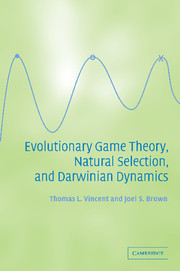Book contents
- Frontmatter
- Contents
- List of figures
- Preface
- 1 Understanding natural selection
- 2 Underlying mathematics and philosophy
- 3 The Darwinian game
- 4 G-functions for the Darwinian game
- 5 Darwinian dynamics
- 6 Evolutionarily stable strategies
- 7 The ESS maximum principle
- 8 Speciation and extinction
- 9 Matrix games
- 10 Evolutionary ecology
- 11 Managing evolving systems
- References
- Index
Preface
Published online by Cambridge University Press: 11 August 2009
- Frontmatter
- Contents
- List of figures
- Preface
- 1 Understanding natural selection
- 2 Underlying mathematics and philosophy
- 3 The Darwinian game
- 4 G-functions for the Darwinian game
- 5 Darwinian dynamics
- 6 Evolutionarily stable strategies
- 7 The ESS maximum principle
- 8 Speciation and extinction
- 9 Matrix games
- 10 Evolutionary ecology
- 11 Managing evolving systems
- References
- Index
Summary
Bernstein et al. (1983) coined the term “the Darwinian dynamic” to describe the dynamical process underlying natural selection. Michod (1999) adds “Darwinian dynamics are systems of equations that satisfy Darwin's conditions of variability, heritability, and the struggle to survive and reproduce.” We take this same view. In fact, for several years, the authors have been collaborating on a particular unifying approach to Darwinian dynamics that puts the study of evolution in a sound mathematical framework by recognizing that natural selection is an evolutionary game. The objective of this book is to explain how the evolutionary game approach along with the concept of a fitness generating function (called a G-function) is used to formulate the equations for Darwinian dynamics. We then show how to use these equations to predict and/or simulate the outcome of evolution. The G-function also produces an adaptive landscape that is useful in analyzing results and drawing conclusions.
After 20 years of development, with our work spread over numerous publications, it was difficult, even for us, to see the whole picture. This book allowed us to draw together and unify our work within one cover. It should be a good reference for anyone interested in the mathematics of evolution. It can also function as a textbook. Working out the details of the examples provides ample homework problems.
This is a book quite unlike any other publication intended for the study of evolution. It might be thought of as mathematical Darwinism. Darwin used logical verbal arguments to understand evolution.
Information
- Type
- Chapter
- Information
- Evolutionary Game Theory, Natural Selection, and Darwinian Dynamics , pp. xv - xviiiPublisher: Cambridge University PressPrint publication year: 2005
